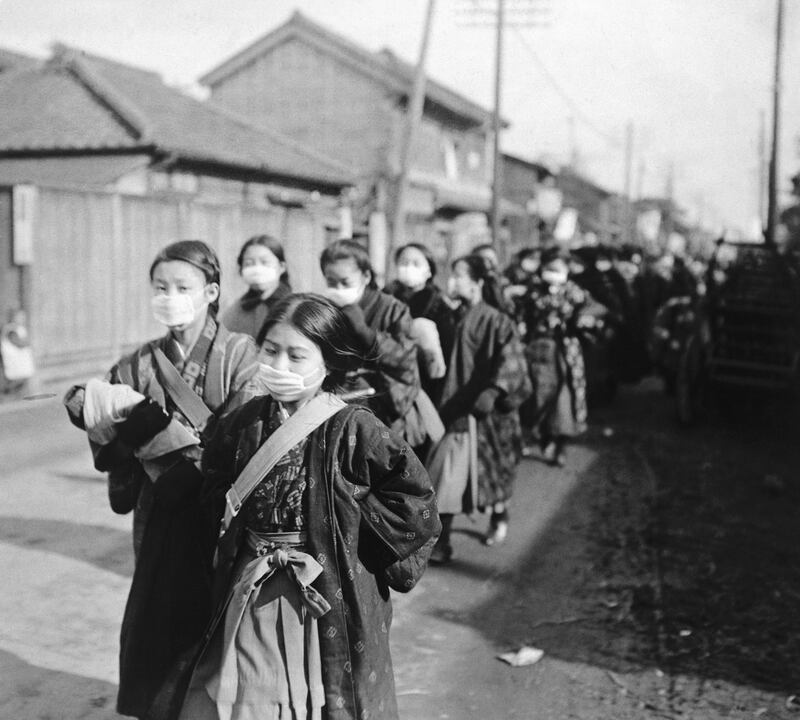Science journalist Laura Spinney's new book, Pale Rider: The Spanish Flu of 1918 and How It Changed the World, details what she refers to as "the greatest massacre of the twentieth century". This was the wave of influenza commonly referred to as "Spanish flu" that swept across the entire planet in 1918, infecting about a third of Earth's population at the time – 500 million people – and killing somewhere in the range of 100 million of those infected before it began to abate in 1920.
That death toll, what Spinney refers to as "a number so big and so round that it seems to glide past any notion of human suffering without even snagging on it", puts the pandemic far beyond the casualty range of the world war that preceded it, and it also reached far beyond the front lines of that war. The world-wide nature of the catastrophe is portrayed very effectively in Spinney's book, making it a perfect complement to John Barry's great 2004 bestseller, The Great Influenza, a stunning, short-strokes portrait of a paralysed international community.
All this damage was done by an enemy that was not even technically alive. Influenza, which has likely killed more humans than any other single cause in history, is a virus, a quasi-alive string of very determined chemicals that do not eat or excrete or procreate. These chemicals do only one thing – replicate themselves. And they cannot even do that unaided; they need to hijack the bodily systems of a living organism in order to make more copies of themselves. This is how flu operates.
Most of Spinney's readers will have some experience of the flu. They will have experienced a miserable week of chills, cough and muscle aches, some missed work time, perhaps a picky appetite upon their return to health. But the most common modern variations of the virus bear little resemblance to the strand that roared to life in the summer of 1918. It was pointedly deadly, striking not the very youngest and the very oldest as viral outbreaks usually do but rather men and women in their prime. This strand of sickness attacked the lungs with such ferocity that it provoked a body-wide overreaction of the immune system, so the stronger the immune system, paradoxically, the more vulnerable the patient.
Tens of thousands of soldiers were stricken, and the disease spread with astonishing speed through the civilian world from the US to the Middle East. Virtually every street of every town in every country was touched by the pandemic; virtually no family escaped unscathed. And the nature of the plague's typical presentation only enhanced the terror of the whole thing. As Spinney points out, the key characteristic of this flu was that a patient was intensely infectious before they showed any symptoms. "For at least a day and sometimes longer, a person may appear to be well though they are infected – and infectious," Spinney writes. "In 1918, if you heard a neighbour or a relation coughing or saw them fall down in front of you, you knew there was a good chance you were already sick yourself."
Those stricken with what the front-line German soldiers referred to as blitzkatarrh went from visible, mobile health to full collapse in a matter of hours, rapidly developing a bluish tint to their skin. In addition to the usual flu symptoms they reported dizziness, hearing loss, and, thanks to optic nerve inflammation caused by the virus, a loss of colour vision. "Many patients remarked, on regaining consciousness, how washed out and dull the world appeared to them," Spinney writes. "As if those cyanosed faces had drained all the colour from it."
As Pale Rider's international scope makes clear, the world of 1918 was very nearly as ill-equipped to confront a gigantic pandemic as the world of 1018 might have been. It was, as Spinney puts it, a world that knew both motor cars and mules but preferred the latter, a world in which quantum theory was being worked out but millions of common folk still believed in witches, a world that "straddled the modern and premodern eras", reacting to this newly rampant influenza with desperate scientific efforts to counteract a thing so small the microscopes of the day could not even see it, but also reacting with older and darker plague gestures such as horse-drawn carts slowly progressing down streets, their drivers calling for people to bring out their dead.
The odd half-formed nature of the early 20th century world, drawn with such affecting humanity by Spinney, only serves to further underscore the tremendous heroism of the doctors and scientists who worked to fight the Spanish flu. Their efforts were ultimately useless – the 1918 influenza strain abated on its own, obeying the weird vagaries of its viral nature or perhaps rapidly evolving into some milder, more successful version of itself, able to sicken people and thus propagate, but not so ferocious as to eradicate its population of potential hosts. These doctors and scientists could combat the secondary bacteriological infections that often attacked patients weakened by the virus, and one of the many strengths of Pale Rider is to show its readers the regional variations that combat took throughout the world, from Bristol Bay to Zamora to Unalaska Island.
Spinney contends that this combat reshaped the world, hastening the collapse of the Central Powers on the First World War battlefield and changing the political landscape everywhere from India to South Africa to Switzerland, in everything from re-drawn representation of decimated centres to an upheaval in the ways central governments respond to epidemics. She argues that the plague played a pivotal role in everything from population genetics to social mobility to the language of art ("The artistic waters didn't flow on smoothly," she writes. "There was a rupture as violent as the parting of the Red Sea"). In the aftermath of war and disease, the still young 20th century drew a deep, nervous breath before stumbling on.
As in all books of this nature, Pale Rider is in many ways as concerned with the future as with the past. The 1918 influenza strain was a classic example of a violent new pathogen striking communities that had no immunological preparation for it – wide-open communities where the virus could wreak havoc virtually unimpeded. The virus mutated as it spread and travelled; it gradually tamed itself.
"If the strain that caused the Spanish fu were to emerge again today, it would likely cause a mild disease, since our immune systems are more or less primed to it," Spinney writes.
"The danger is that a new strain appears in our midst, to which nobody alive has ever been exposed."
One of the book's best sections is "Roscoe's Legacy", a short chapter in which Spinney speculates on what the next great pandemic might be. Influenza still kills about 60,000 people every year, but the concentration in this chapter is on the next truly wildfire event, an airborne and easily communicated new virus that erupts from slums or farmland and spreads quickly in a world that is much more interconnected than it was in 1918.
In such a scenario, the influenza pandemic of a century ago may pay its most valuable dividend. For all the tragedies and upheavals, the book portrays, Pale Rider actually paints an oddly hopeful picture of a population more sensitised to early warnings and largely more willing to heed them. "Fear makes people vigilant," Spinney writes. "It impels them to notice things they might not otherwise have noticed; to pay attention to certain associations and ignore others; to remember prophecies they might previously have dismissed as absurd."
Methods of prediction, prevention and treatment have all vastly improved since 1918, often in direct response to that epidemic. Which is just as well, since that next pandemic will almost certainly be another strain of influenza, back to try again.






